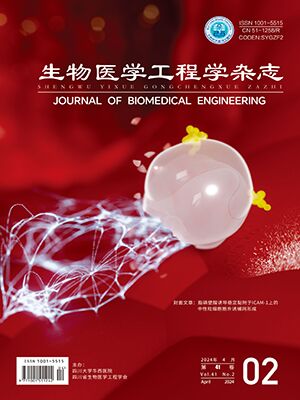| 1. |
张瑞, 宋江玲, 胡文凤. 癫痫脑电的特征提取方法综述. 西北大学学报(自然科学版), 2016, 46(6): 781-788,794.
|
| 2. |
Sharma R, Pachori R B. Classification of epileptic seizures in EEG signals based on phase space representation of intrinsic mode functions. Expert Syst Appl, 2015, 42(3): 1106-1117.
|
| 3. |
Zabihi M, Kiranyaz S, Jäntti V, et al. Patient-specific seizure detection using nonlinear dynamics and nullclines. IEEE J Biomed Health Inform, 2019, 24(2): 543-555.
|
| 4. |
Jaffino G, Jose J P, Kumar K S. Expectation-maximization extreme machine learning classifier for epileptic seizure detection// 2021 International Conference on Forensics, Analytics, Big Data, Security (FABS). Bengaluru: IEEE, 2021, 1: 1-5.
|
| 5. |
徐嘉阳, 杨婷婷, 李雯, 等. 基于自适应多尺度脑功能连接的局灶性癫痫发作检测方法研究. 中国生物医学工程学报, 2022, 41(4): 393-401.
|
| 6. |
Rajaguru H, Santhosh B. Logistic regression classifier with hybrid dimensionality reduction techniques for epilepsy detection from EEG signals// 2022 Smart Technologies, Communication and Robotics (STCR). Sathyamangalam: IEEE, 2022: 1-5.
|
| 7. |
Ashokkumar S R, Premkumar M, Dhilipkumar P, et al. Application of multi-domain feature for automated seizure detection from EEG signal// 2022 3rd International Conference on Smart Electronics and Communication (ICOSEC). Trichy: IEEE, 2022: 280-285.
|
| 8. |
Yuan S, Liu X, Shang J, et al. Automatic seizure detection using Logarithmic Euclidean-Gaussian Mixture Models (LE-GMMs) and improved Deep Forest learning. IEEE J Biomed Health Inform, 2022, 27(3): 1386-1396.
|
| 9. |
Zubair M, Belykh M V, Naik M U K, et al. Detection of epileptic seizures from EEG signals by combining dimensionality reduction algorithms with machine learning models. IEEE Sens J, 2021, 21(15): 16861-16869.
|
| 10. |
Hussain W, Wang B, Niu Y, et al. Epileptic seizure detection with permutation fuzzy entropy using robust machine learning techniques. IEEE Access, 2019, 7: 182238-182258.
|
| 11. |
Yao X, Li X, Ye Q, et al. A robust deep learning approach for automatic classification of seizures against non-seizures. Biomed Signal Process Control, 2021, 64: 102215.
|
| 12. |
Hu X, Yuan S, Xu F, et al. Scalp EEG classification using deep Bi-LSTM network for seizure detection. Comput Biol Med, 2020, 124: 103919.
|
| 13. |
Shen M, Wen P, Song B, et al. Real-time epilepsy seizure detection based on EEG using tunable-Q wavelet transform and convolutional neural network. Biomed Signal Process Control, 2023, 82: 104566.
|
| 14. |
Fukumori K, Yoshida N, Sugano H, et al. Epileptic spike detection by recurrent neural networks with self-attention mechanism// ICASSP 2022-2022 IEEE International Conference on Acoustics, Speech and Signal Processing (ICASSP). Singapore: IEEE, 2022: 1406-1410.
|
| 15. |
Sharan R V, Berkovsky S. Epileptic seizure detection using multi-channel EEG wavelet power spectra and 1-D convolutional neural networks// 2020 42nd Annual International Conference of the IEEE Engineering in Medicine & Biology Society (EMBC). Montreal: IEEE, 2020: 545-548.
|
| 16. |
Chatzichristos C, Dan J, Narayanan A M, et al. Epileptic seizure detection in EEG via fusion of multi-view attention-gated U-net deep neural networks// 2020 IEEE Signal Processing in Medicine and Biology Symposium (SPMB). Philadelphia: IEEE, 2020: 1-7.
|
| 17. |
Ma Y, Huang Z, Su J, et al. A multi-channel feature fusion CNN-Bi-LSTM epilepsy EEG classification and prediction model based on attention mechanism. IEEE Access, 2023, 11: 62855-62864.
|
| 18. |
Zhao Y, Chu D, He J, et al. Interactive local and global feature coupling for EEG-based epileptic seizure detection. Biomed Signal Process Control, 2023, 81: 104441.
|
| 19. |
Tian X, Deng Z, Ying W, et al. Deep multi-view feature learning for EEG-based epileptic seizure detection. IEEE Trans Neural Syst Rehabilitation Eng, 2019, 27(10): 1962-1972.
|
| 20. |
Ke N, Lin T, Lin Z. Channel-weighted squeeze-and-excitation networks for epileptic seizure detection// 2021 IEEE 33rd International Conference on Tools with Artificial Intelligence (ICTAI). Washington: IEEE, 2021: 666-673.
|
| 21. |
Li Y, Liu Y, Cui W G, et al. Epileptic seizure detection in EEG signals using a unified temporal-spectral squeeze-and-excitation network. IEEE Trans Neural Syst Rehabil Eng, 2020, 28(4): 782-794.
|
| 22. |
He J, Cui J, Zhang G, et al. Spatial–temporal seizure detection with graph attention network and bi-directional LSTM architecture. Biomed Signal Process Control, 2022, 78: 103908.
|
| 23. |
Poorani S, Balasubramanie P. Deep learning based epileptic seizure detection with EEG data. Int J Syst Assur Eng Manag, 2023: 1-10.
|
| 24. |
Kevric J, Subasi A. The effect of multiscale PCA de-noising in epileptic seizure detection. J Med Syst, 2014, 38: 1-13.
|




